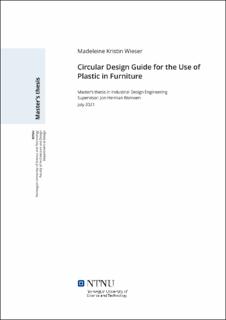| dc.contributor.advisor | Rismoen, Jon Herman | |
| dc.contributor.advisor | Diez, Stefan | |
| dc.contributor.author | Wieser, Madeleine Kristin | |
| dc.date.accessioned | 2021-11-12T18:20:26Z | |
| dc.date.available | 2021-11-12T18:20:26Z | |
| dc.date.issued | 2021 | |
| dc.identifier | no.ntnu:inspera:73563866:24432358 | |
| dc.identifier.uri | https://hdl.handle.net/11250/2829428 | |
| dc.description.abstract | Denne masteroppgaven fokuserer på sirkulæriteten til plast i møbelindustrien, eller som gjennom denne oppgaven ble oppdaget at kan sies å være en bedre beskrivelse, den tilsynelatende ikke-eksisterende sirkulæriteten til plast i møbelindustrien. Masteroppgaven ble utført i samarbeid med den internasjonalt anerkjente designeren Stefan Diez, og målet har vært å undersøke og evaluere sirkulæriteten til plast i møbelindustrien.
Hovedmetoden brukt for denne masteroppgaven har vært intervjuer. Masteroppgaven omfatter 19 intervjuer med designere, eksperter på plastresirkulering og ressurspersoner i forskjellige bedrifter, hvorav de fleste bedriftene var møbelprodusenter. Teoretisk research ble også gjennomført underveis, samt en casestudie.
Masteroppgaven kan deles inn i tre faser, den første er industriinnsiktsfasen, der intervjuer med representanter for møbelprodusenter ble gjennomført for å identifisere utfordringene industrien står ovenfor med hensyn til sirkulæriteten til plast. Den andre fasen var casestudien der forskjellige stoler som produsentene hevdet at inneholder resirkulert og/eller resirkulerbar plast ble analysert for å evaluere den nåværende sirkulæriteten i bransjen. Disse to fasene avslørte at det for tiden ikke ser ut til å eksistere en sirkulær økonomi for plast i møbelindustrien, i det minste ikke blant det som er undersøkt for denne oppgaven. Sirkulære systemer ser ut til å mangle og plastmøbler ser i beste fall ut til å være «circular-ish». Videre har fase en og to tjent til å identifisere de nødvendige endringene som må til for å gå fra linearitet til sirkulæritet i møbelindustrien, spesielt for bruk av plast.
Den siste fasen av masteroppgaven var å utvikle en sirkulær designguide for bruk av plast i møbler, som er resultatet av denne oppgaven. Den sirkulære designguiden, som er basert på funnene fra fase en og to, oppsummerer alle funn fra denne masteroppgaven i et sett med tolv retningslinjer. Guiden er ment å fremme overgangen til en sirkulær økonomi for plast i møbelindustrien ved å hjelpe designere designe sirkulære plastmøbler, som vil være klare til å sirkulere når sirkulære systemer har blitt etablert. | |
| dc.description.abstract | This master’s thesis focuses on the circularity of plastics in the furniture industry, or what through this thesis was discovered to be a more accurate description, the seemingly non-existing circularity of plastics in the furniture industry. The thesis was conducted in collaboration with internationally renowned designer Stefan Diez, and the aim of it has been to investigate and evaluate the circularity of plastics in the furniture industry.
The main method used for this thesis has been interviews. This thesis contains 19 interviews with designers, experts on plastic recycling and representatives of different companies, mostly furniture manufacturing companies. Theoretical research was also conducted along the way, as well as a case study.
The thesis can be divided into three phases, the first phase is the industry insight phase, where interviews were conducted with furniture manufacturer representatives to identify the challenges facing the industry in regard to the circularity of plastics. The second phase was the case study where different chairs that the manufacturers claimed contained recycled and/or recyclable plastic were analyzed as a means to assess the current state of circularity in the industry. These two phases revealed that there currently does not seem to be a circular economy for plastic in the furniture industry, at least not amongst what has been examined for this thesis. Circular systems seem to be missing, and plastic furniture seems to at best be circular-ish. Furthermore, phase one and two served to identify the changes needed to transition from linearity to circularity in the furniture industry, especially for the use of plastic.
The last phase of the thesis was to develop a circular design guide for the use of plastic in furniture, which is the result of this thesis. The circular design guide, based on the findings from phase one and two, sums up all findings of this thesis into a set of twelve guidelines. This guide is meant to advance the transition to a circular economy for plastics in the furniture industry by helping designers design circular plastic furniture, that will be ready to circulate once circular systems have been established. | |
| dc.language | eng | |
| dc.publisher | NTNU | |
| dc.title | Circular Design Guide for the Use of Plastic in Furniture | |
| dc.type | Master thesis | |
